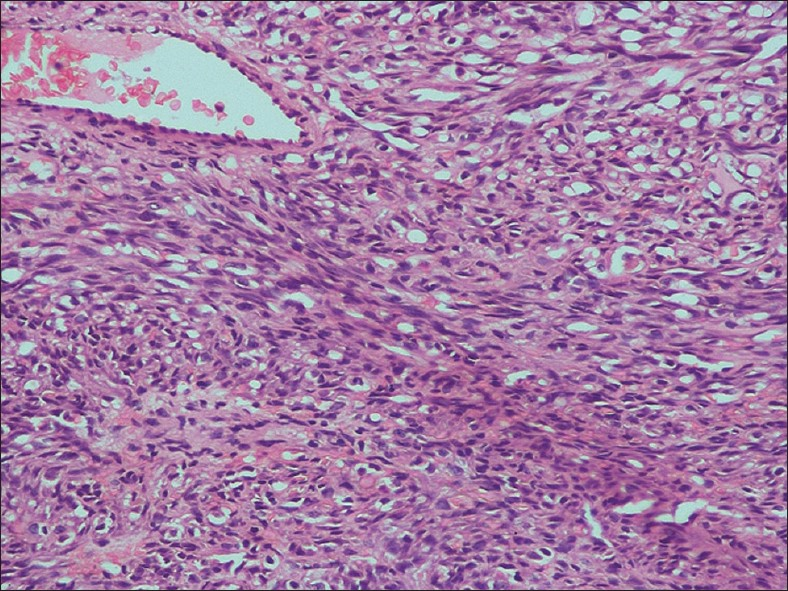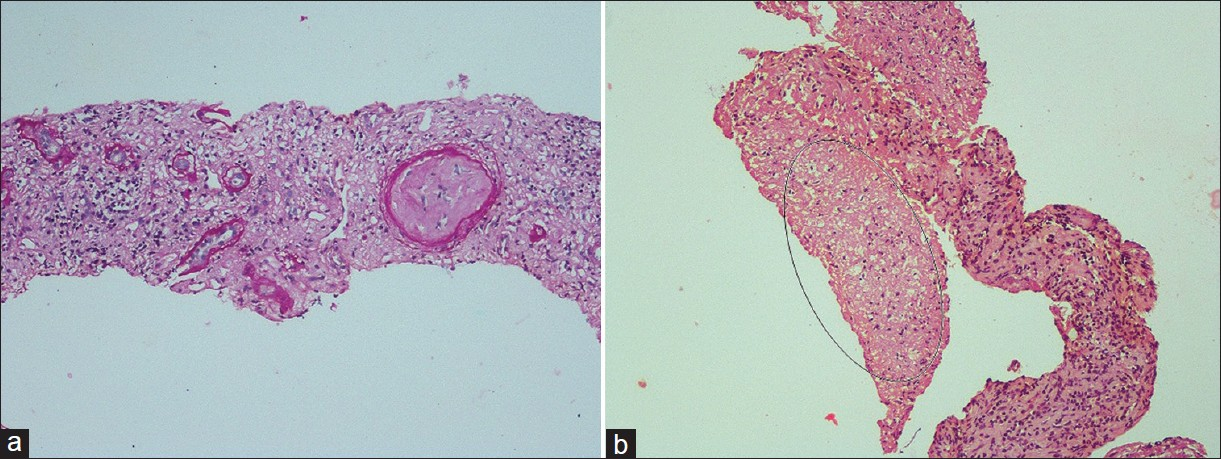Translate this page into:
Late post transplant HIV infection with BK viremia and allograft tuberculosis in a renal transplant recipient with Kaposi sarcoma
This is an open-access article distributed under the terms of the Creative Commons Attribution-Noncommercial-Share Alike 3.0 Unported, which permits unrestricted use, distribution, and reproduction in any medium, provided the original work is properly cited.
This article was originally published by Medknow Publications & Media Pvt Ltd and was migrated to Scientific Scholar after the change of Publisher.
Abstract
In this report, we discuss a case of a 51-year-old African renal transplant who presented with metastatic Kaposi sarcoma 1 year after transplant. The Kaposi sarcoma was treated with a switch of immunosuppressants and chemotherapy. Six years after transplant, he presented with chronic allograft nephropathy, allograft tuberculosis, BK viremia, and was diagnosed to have contracted HIV infection.
Keywords
BK viremia
human immunodeficiency virus
kaposi sarcoma
kidney transplantation
sirolimus
tuberculosis
Introduction
According to estimates from the UNAIDS Global Report 2010, at the end of the year 2009 the prevalence of HIV worldwide was around 30.8 million in adults and 2.5 million in children.[1] AIDS killed 2.1 million people in the course of that year, including 3,30,000 children, and 76% of those deaths occurred in sub-Saharan Africa. Unfortunately, these are the areas where tuberculosis (TB) has been flourishing unhindered, forming a deadly combination. The advent of HIV/AIDS has led to a dramatic increase in the number of TB cases worldwide. The etiology of Kaposi's sarcoma is multifactorial and a combination of immunosuppression combined with a hereditary predisposition to the disease[2] is responsible for the major increase in its incidence in renal transplant recipients.
We present a case of a 51-year-old Tanzanian male hypertensive renal transplant recipient, who came to our attention when he presented with Kaposi Sarcoma, and later with HIV infection 6 years after transplantation along with allograft TB and BK viremia.
Case Report
A 51-year-old male from Tanzania, a hypertensive, on maintenance hemodialysis since June 2005, underwent a live related renal transplantation on 13/09/2005. His serology for HIV 1 and 2, hepatitis B, hepatitis C was negative. He had a history of blood transfusion (6 units) in June 2005 in his native country. His post-operative period was uneventful. He was inducted with a single dose of basiliximab on the day of transplantation and his immunosuppressants were prednisolone 15 mg, Mycophenolate Mofetil (MMF)–500 mg B.D, cyclosporin 175/150 microemulsion on discharge while returning to his country. The patient developed new onset diabetes after transplantation (NODAT). On discharge (6/10/2005) his blood urea was 31 mg/dL and serum creatinine was 1.1 mg/dL.
He returned to Tanzania and was followed-up there. He came back for a review 1 year later when his investigations showed urea 36 mg/dL, creatinine 1.2 mg/dL. Three months later, he presented with a rapidly progressive ulcerative lesion on his right thigh associated with swelling of the right lower limb. The ulceroproliferative lesion was 20 × 15 cm with skin discoloration and bilateral palpable inguinal lymph nodes. Investigations showed urea 53 mg/dL, creatinine 1.4 mg/dL, sodium 133.4 mEq/L, potassium 4.09 mEq/L, chloride 107 mEq/L, and bicarbonate 23.2 mEq/L. Wedge biopsy of the skin lesion showed pseudoepitheliomatous hyperplasia and inguinal lymph node biopsy suggesting features consistent with Kaposi sarcoma [Figure 1]. Repeated testing of HIV was negative and staining for acid-fast bacilli was negative Epstein-Barr virus IgG 22.6 and IgM 8.5. He was started on chemotherapy (liposomal doxorubicin). MMF was stopped, and cyclosporin and prednisolone were tapered with the plan of stopping in 2-3 weeks. He was started on sirolimus 5 mg once a day. On discharge, his investigations were urea 44 mg/dL, creatinine 2.3 mg/dL, sodium 124.6 mEq/L, potassium 5.03 mEq/L, chloride 96 mEq/L, bicarbonate 18.6 mEq/L, Hb 8.4 gm/dL, and TWBC 7500 cells/mm3. He received three doses of chemotherapy.

- Kaposi's sarcoma
On follow-up, his Kaposi sarcoma lesion had regressed. His blood urea was 37 mg/dL and creatinine 1.3 mg/dL. He was given one dose of liposomal doxorubicin 40 mg on 15/3/2007. His right leg venous Doppler was normal. He was discharged with sirolimus monotherapy. His follow-up on 8/12/2007 was uneventful with blood urea 42 mg/dL, creatinine 1.5 mg/ dL, and he was continued on the same line of treatment.
On 20/05/2011, he presented with hematuria and high-grade fever. He had diarrhea for 3 days without blood or mucus. Stool analysis was unremarkable and the diarrhea settled. His investigations were blood urea 91 mg/dL, creatinine –3.1 mg/dL, sodium 133 mEq/L, potassium 3.7 mEq/L, chloride 98 mEq/L, bicarbonate 25.8 mEq/L, c alcium 9.2 mg/dL, phosphorus 3.4 mg/dL. Imaging of the chest did not show any lung parenchymal or pleural lesion. He tested positive for HIV with a viral load of 564407 IU/mL, CD4 count was 241 cells/mL and CD8 was 846 cells/mL. He denied any risky sexual behavior or IV drug abuse. Renal biopsy suggested features of chronic allograft nephropathy (CAN) [Figure 2a] with ill- defined granulomas suggestive of TB [Figure 2b]. Nuclear amplification test of the urine for TB was positive. He was also diagnosed with BK viremia. He was started on antituberculous therapy (ATT) (isoniazid 150 mg once a day, pyrazinamide 750 mg twice a day, levofloxacin 500 mg twice a day, pyrodoxine 40 mg once a day). Antiretroviral drugs (zidovudine 300 mg twice a day, lamivudine 150 mg twice a day, efavirenz 600 mg twice a day) were initiated after discussion with ID consultant. His sirolimus dose was reduced to 3 mg once daily with a through level of 4.56 ng/dL. He became afebrile after a week of ATT and macroscopic hematuria disappeared. He was discharged with advice of regular follow-up.

- (a) Chronic allograft nephropathy. (b) A fragment of necrotic tissue is seen along with an ill-defined epithelioid granulomatous inflammation
Discussion
This case report illustrates a post-renal transplant patient with newly diagnosed HIV infection with a high viral load. The patient had a history of blood transfusion and Kaposi Sarcoma. Even after repeated questioning, he denied having any high risk sexual behavior. The donor was his brother, who was negative for HIV 1 and 2.
After transplantation, the patient was started on triple immunosuppressant therapy. He was switched over to sirolimus monotherapy, which inhibits the progression of dermal Kaposi's sarcoma in kidney-transplant recipients while providing effective immunosuppression.[3] Subsequently, he tested positive for HIV and renal biopsy and nuclear amplification test showed evidence of TB and he was started on antiretroviral therapy and antituberculous drugs. The sensitivity of the nuclear amplification test is 63-95% and the specificity is 96%. As the method used is an RNA polymerase RPOB and PCR assay based on DNA coding for 16s rRNA, the false positive rate is less than 10%. The EM did not reveal any additional findings. The immunohistochemical stains performed on the tissue for CMV was negative.
His sirolimus dose was lowered, as lowering the dose of sirolimus with Antiretroviral Therapy (ART) has been shown to improve kidney function,[4] showing that combination of immunosuppression with ART may be nephrotoxic. While Efavirenz is recommended at 600 mg once daily for adults weighing 88 pounds, as ATT therapy was also initiated, we increased the dosage of efavirenz. Despite discontinuing Calcineurin Inhibitor (CNI) in 2006, while continuing rapamycin as a monotherapy, he had progression of CAN.
In a study by Kumar et al., it was shown that HIV patients maintained on ART are capable of mounting an immune response, with a rejection rate of 25%.[5] This indicates without immunosuppression, they will reject the allograft. A balance of immunosuppression and ART is essential in this patient.
Furthermore, treatment of TB in a patient with renal transplantation requires caution. Rifampicin induces cytochrome P450, which is responsible for metabolizing cyclosporine, sirolimus, and prednisolone. This unpredictable interaction has led to acute rejections in 30% and graft loss is 20%, and hence rifampicin should be avoided in kidney transplantation.[6] Rifabutin is a potential alternative with less p450 interaction. Quinolones with antimycobacterial property are usually added to the regimen.[7]
The monitoring of patients on combined immunosuppression, ATT, and ART is challenging due to major drug interactions and requires meticulous surveillance. Managing the pharmacokinetics, the complicated drug interaction profile, and combined toxicity of immunosuppressants, ATT, and ART is a complex task. There are no data regarding long-term outcomes of combining immunosuppressant with ART and ATT. Long-term studies of patient and graft outcomes and the effect of prolonged immunosuppression on HIV therapy are required.
In large parts of the world, there is no infrastructure for TB diagnosis. The duration of ATT in post-transplant immunosuppressed patients with HIV infection should be 18 months. The defervescence and relief of hematuria suggested response to ATT. MDR TB is on the rise in South Africa. WHO figures from 2009 show infection rates of over 300/100000, often commonly in association with underlying HIV infection. Extra pulmonary TB is seen in up to 43% in the United Kingdom. The diagnosis of TB is frequently fraught with difficulty. Simple, but powerful molecular diagnostic testing is employed. Proteomic technologies are currently used to distinguish active from latent TB+.[8]
A majority of people with HIV infection are asymptomatic for substantial and variable length of time. When CD4 <100/mm3, disseminated infections are common with low virulence organisms. Our patient had CD4 240 mm3; hence, there was functioning immune response to normal organisms. As HIV infection progresses, the viral load rises and CD4 count falls.
Most patients seroconvert within 4 to 10 weeks and ≥95% seroconvert within 6 months.[9–11] The median time from exposure to positive serology in one study was 63 days.[12] Hence, it is very unlikely that he was in the pre-serology conversion stage at the time of diagnosis of Kaposi sarcoma. His Kaposi sarcoma was likely related to immunosuppressive medications on the HHV-8. The incidence of Kaposi's Sarcoma is 0.02%. Of this, 0.2% of all Kaposi's Sarcoma is the classical non-HIV form and hence, non-HIV Kaposi sarcoma (KS) is extremely rare.
The BK viremia is another complex issue in this patient who was on monotherapy with sirolimus. Reduction of sirolimus dosage and follow-up for BK viremia is an essential step in the management of this patient.
In conclusion, we present a male patient with CAN, late onset HIV infection, previous treated Kaposi sarcoma, BK viremia, and allograft TB.
Source of Support: Nil
Conflict of Interest: We have had no involvements that might raise the question of bias in the work reported or in the conclusions, implications, or opinions stated.
References
- UNAIDS. ‘Unite for universal access: Overview brochure on 2011 High Level Meeting on AIDS’. 2010
- [Google Scholar]
- Racial and ethnic variations in incidence and pattern of malignancies after kidney transplantation. Medicine (Baltimore). 2005;84:12-22.
- [Google Scholar]
- Sirolimus for Kaposi's sarcoma in renal-transplant recipients. N Engl J Med. 2005;352:1317-23.
- [Google Scholar]
- Safety and success of kidney transplantation and concomitant immunosuppression in HIV-positive patients. Kidney Int. 2005;67:1622-9.
- [Google Scholar]
- Mycobacterium tuberculosis infection in solid-organ transplantation recipients: Impact and implications for management. Clin Infect Dis. 1998;27:1266-77.
- [Google Scholar]
- Rapid molecular detection of tuberculosis and rifampicin resistance. N Engl J Med. 2010;363:1005-15.
- [Google Scholar]
- Absence of prolonged immunosilent infection with human immunodeficiency virus in individuals with high-risk behaviors. Am J Med. 1994;96:42-8.
- [Google Scholar]
- HIV antigen and antibody detection: Variable responses to infection in the Edinburgh haemophiliac cohort. Br Med J (Clin Res Ed). 1988;296:593-8.
- [Google Scholar]
- HIV-1 PCR and isolation in seroconverting and seronegative homosexual men: Absence of long-term immunosilent infection. J Acquir Immune Defic Syndr. 1993;6:1339-46.
- [Google Scholar]







